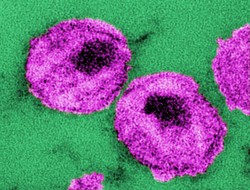The clinical course of infection with human immunodeficiency virus (HIV) includes acute, chronic, and acquired immunodeficiency syndrome (AIDS) phases. Though the final phase is when signs and symptoms generally appear, there are, in some patients, manifestations that the patient may notice during the acute stage [1]. Specifically, there may be swelling of the lymph nodes and other symptoms which resemble a viral or influenza infection a matter of days after the patient acquires HIV infection.

The Clinical Course of HIV
Infection with human immunodeficiency virus may lead to various clinical manifestations and progression.
Acute Phase
Within a few weeks of the initial infection, HIV infects billions of human cells [3]. As this process takes place during the acute phase, which may last for several weeks, this is a period in which the patient is especially contagious should he or she have unprotected intercourse with someone. The occurrence of HIV seroconversion--in which the test changes from negative to positive--takes place between six and twelve weeks after the patient acquires HIV.
The development of new test assays, however, has enabled the occurrence of seroconversion to take place more quickly than in the past, and some laboratory tests will become positive in less than two weeks after the initial infection takes place.
Nevertheless, the patient may assume that the symptoms of the acute phase are the result of influenza or some other common viral infection, and it is conceivable that he or she will not go for an HIV test.
Latent Phase
Though the degree of contagiousness declines significantly in the latent or chronic phase of HIV infection, the patient can still transmit the disease through unprotected sex. This second phase may last for eight years without the appearance of any clinical signs or symptoms. Unless the individual has an HIV test, he or she may not know all these years that the medical condition is present [1].
The status of the person's immune system prior to HIV infection will determine how long the chronic phase will last. The better the immune system, the longer the patient may continue without symptoms or even suspicion that the illness is already in progress. Moreover, the virulence of microbial strain will determine duration of the latent phase [3].
Hence, some patients may continue without symptoms for as many as 28 years even though they have never taken antiretroviral drugs [3].
Acquired Immunodeficiency Syndrome
The final phase of the disease is where the CD4 cell count falls below 200 per cubic millimeter. The patient acquires opportunistic infections such as Pneumocystis jiroveci or Mycobacterium. Furthermore, HIV encephalopathy or other serious medical conditions such as nephropathy may become evident [2]. Without antiretroviral therapy, the patient succumbs to AIDS within a few years. Nevertheless, the use of antiretroviral drugs may enable patients with HIV infection to survive for three to four decades after initial acquisition of the disease.
Experience with highly active antiretroviral therapy has only taken place for 17 years as this major public health breakthrough occurred in 1996. The question that arises is whether patients will be able to tolerate the drugs for 30 or 40 years. It is well-known, for example, that antiretroviral agents lead to lipid abnormalities, elevation of blood sugar, and heart problems [1].
The final phase of the disease may also include persistent diarrhea, weakness, loss of muscle mass or wasting, weight loss, anorexia, and recurrent or persistent fever [1].
In conclusion, infection with HIV/AIDS is a progressive medical condition which has a clinical course, though largely asymptomatic, over many years. Developments in its treatment have made it a manageable chronic disease.
References
1. AIDS.gov. (2009). Stages of HIV. Retrieved April 6, 2013.
2. AIDS Education and Training Centers National Resource Center. (2013). HIV classification: CDC and WHO Staging Systems. Retrieved April 6, 2013.
3. Bartlett, J. (2005). The Johns Hopkins Hospital 2005-2006 Guide to Medical Care of Patients with HIV Infection, 12th edition. Philadelphia: Lippincott Williams and Wilkins.
4. The color photograph is a thin-section transmission electron micrograph of human immunodeficiency virus particles. Reprinted with permission from Centers for Disease Control/Dr. A. Harrison/Dr. P. Feorino.
Disclaimer
The information contained in this article is for educational purposes only and should not be used for diagnosis or to guide treatment without the opinion of a health professional. Any reader who is concerned about his or her health should contact their physician for advice.
You might also like
How to React to and Help a Loved One with CancerDealing with cancer? Learn how to react, treat and care for a loved one when ...
Do You Have Your Own Cure For Cancer?Is it possible you might be completely unaware of the cancer cure, a natural ...



 The Reality of Aspirinon 05/24/2021
The Reality of Aspirinon 05/24/2021
 An Old Microbeon 03/31/2021
An Old Microbeon 03/31/2021
 Coronavirus and Mental Illnesson 02/14/2021
Coronavirus and Mental Illnesson 02/14/2021
 Acute Ischemic Strokeon 12/25/2020
Acute Ischemic Strokeon 12/25/2020


Comments